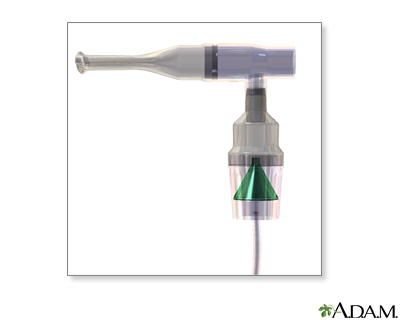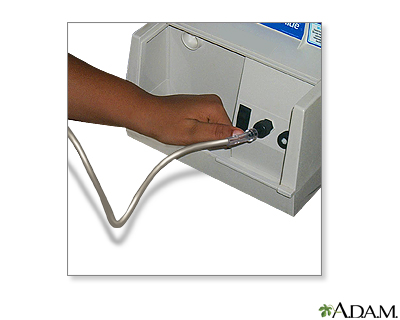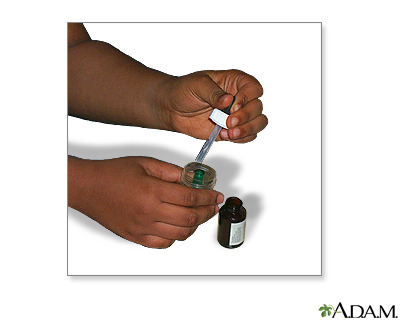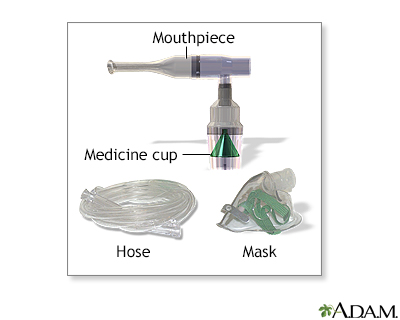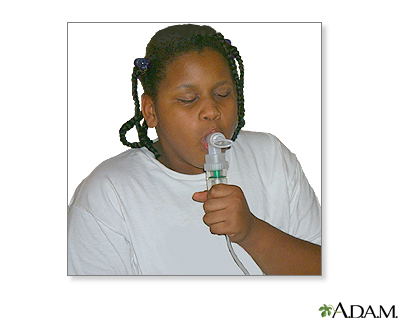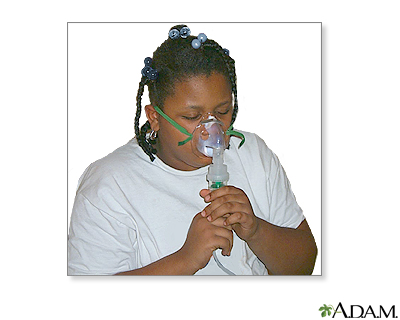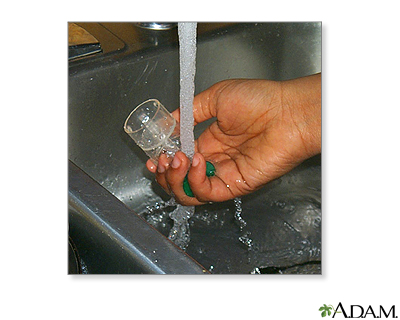How to use a nebulizer
Nebulizer - how to use; Asthma - how to use a nebulizer; COPD - how to use a nebulizer; Wheezing - nebulizer; Reactive airway disease - nebulizer; COPD - nebulizer; Chronic bronchitis - nebulizer; Emphysema - nebulizer; Chronic obstructive pulmonary disease - nebulizer; Cystic fibrosis - nebulizerA nebulizer is a small machine that turns liquid medicine into a mist that can be easily inhaled. You sit with the machine and breathe in the medicine through a connected mouthpiece or facemask. This allows the medicine to enter the lungs directly.
Nebulizers may be used for people with lung disease, including:
-
Asthma
Asthma
Asthma is a chronic disease that causes the airways of the lungs to swell and narrow. It leads to breathing difficulty such as wheezing, shortness o...
 ImageRead Article Now Book Mark Article
ImageRead Article Now Book Mark Article - Chronic obstructive pulmonary disease (COPD)
COPD
Chronic obstructive pulmonary disease (COPD) is a common lung disease. Having COPD makes it hard to breathe. There are two main forms of COPD:Chroni...
 ImageRead Article Now Book Mark Article
ImageRead Article Now Book Mark Article -
Cystic fibrosis
Cystic fibrosis
Cystic fibrosis is a disease that causes thick, sticky mucus to build up in the lungs, digestive tract, and other areas of the body. It is one of th...
 ImageRead Article Now Book Mark Article
ImageRead Article Now Book Mark Article -
Bronchiectasis
Bronchiectasis
Bronchiectasis is a disease in which the large airways in the lungs are damaged. This causes the airways to become permanently wider. Bronchiectasis...
 ImageRead Article Now Book Mark Article
ImageRead Article Now Book Mark Article
Types of Nebulizers
Most nebulizers work by using air compressors to create the mist containing the medicine. A different kind, called an ultrasonic nebulizer, uses sound vibrations. Nebulizers come in three main types:
- Jet - Compressed air turns the medicine into a mist (tiny particles of medicine that float in the air).
- Mesh - Medicine is passed through a tiny mesh to create a fine mist.
- Ultrasonic - High frequency vibrations turn medicine into a mist. The droplets tend to be a bit larger. This kind of nebulizer is quieter, but costs more.
A nebulizer can be a smaller portable device or a plug-in tabletop machine you use at home. You will need a prescription from your health care provider to get a nebulizer. Check with your health plan to see if it will cover the cost of the device. Most plans will cover it.
Setting Up and Using a Nebulizer
Use your nebulizer according to the manufacturer's instructions.
The basic steps to set up and use your nebulizer are as follows:
- Wash your hands.
- Connect the hose to an air compressor.
- Fill the medicine cup with your medicine. To avoid spills, close the medicine cup tightly and always hold the mouthpiece straight up and down.
- Attach the other end of the hose to the mouthpiece and medicine cup.
- Turn on the nebulizer machine.
- Place the mouthpiece in your mouth. Keep your lips firmly around the mouthpiece so that all of the medicine goes into your lungs. If using a facemask, place it over the mouth and nose. Small children usually do better if they wear a mask.
- Breathe through your mouth until all the medicine is used. This takes 5 to 20 minutes, depending on the device and medicine used. If needed, use a nose clip so that you breathe only through your mouth.
- Turn off the machine when done.
- Wash the medicine cup and mouthpiece with water and air dry until your next treatment.
Taking Care of Your Nebulizer
You will need to clean your nebulizer to prevent bacteria from growing in it, since bacteria can cause a lung infection. It takes some time to clean your nebulizer and keep it working properly. Be sure to unplug the machine before cleaning it.
After each use:
- Wash the medicine cup and mouthpiece with warm running water.
- Let them air dry on clean paper towels.
- Later, hook up the nebulizer and run air through the machine for 20 seconds to make sure all of the parts are dry.
- Take apart and store the machine in a covered area until the next use.
Once per day, you may add a mild dish soap to the cleaning routine above.
Once or twice each week:
- You may add a soaking step to the cleaning routine above.
- Soak the cup and mouthpiece in 1 part distilled white vinegar, 2 parts warm water solution.
You may clean the outside of your machine with a warm, damp cloth as necessary. Never wash the hose or tubing.
You will also need to change the filter. The instructions that come with your nebulizer will tell you when you should change the filter.
Nebulizers vs. Inhalers
Like nebulizers, inhalers are also used to send medicine into your lungs. But there are differences.
Inhalers
Using a metered-dose inhaler (MDI) seems simple. But many people do not use them the right way. If you use your MDI the wrong way, less medicine ge...

Inhalers:
- Quickly deliver an exact dose of medicine
- Take a little practice to use properly
- Are smaller and more portable
- Cost less and tend to have fewer side effects than nebulizers, such as rapid heartbeat and jitteriness
Nebulizers:
- Allow you to see and feel the medicine as you breathe it in.
- Can be easier to use because all you have to do is breathe normally. This makes them a good choice for young children and for people with severe lung disease.
- Take at least 5 to 10 minutes or more to deliver the medicine.
- May be larger and more bulky, making it harder to use for travel or work.
If you have asthma, you may not need to use a nebulizer. You may use an inhaler instead, which is usually just as effective if used properly. But a nebulizer can deliver medicine with less effort and greater predictability than an inhaler. You and your provider can decide if a nebulizer is the best way to get the medicine you need.
The choice of device you use may be based on whether you find a nebulizer easier to use and what type of medicine you take.
Below are examples of medicines that may be used with a nebulizer:
Bronchodilators work by relaxing the muscles of your airways, and this lets you breathe better during an attack or flare-up. Examples include:
- Albuterol
- Ipratropium
- Levalbuterol
Corticosteroids help prevent airways from becoming inflamed and help prevent symptoms. These include:
- Budesonide
- Flunisolide
- Fluticasone
- Triamcinolone
Nebulizers also may be used with:
- Certain inhaled antibiotics to treat lung infections
- Sterile saline solution or medicines to help loosen up mucus in the lungs
Note: This is not a comprehensive list of medicines.
When to Call the Doctor
Contact your provider or medical device supplier if you are having trouble using your nebulizer. You should also contact your provider if you have any of these problems while using your nebulizer:
- Anxiety
- Feeling that your heart is racing or pounding (palpitations)
Palpitations
Palpitations are feelings or sensations that your heart is pounding or racing. They can be felt in your chest, throat, or neck. You may:Have an unpl...
 ImageRead Article Now Book Mark Article
ImageRead Article Now Book Mark Article - Shortness of breath
- Feeling very excited
These may be signs that you are getting too much medicine.
References
Global Initiative for Chronic Obstructive Lung Disease (GOLD) website. Global strategy for the diagnosis, management, and prevention of chronic obstructive pulmonary disease: 2023 report. goldcopd.org/2023-gold-report-2/. Accessed February 8, 2024.
Han MK, Lazarus SC. COPD: diagnosis and management. In: Broaddus VC, Ernst JD, King TE, et al, eds. Murray and Nadel's Textbook of Respiratory Medicine. 7th ed. Philadelphia, PA: Elsevier; 2022:chap 64.
Janssens HM, Schultz A. Aerosol therapy in children. In: Bush A, Deterding R, Li AM, et al, eds. Kendig and Wilmott's Disorders of the Respiratory Tract in Children. 10th ed. Philadelphia, PA: Elsevier; 2024:chap 14.
Laube BL, Dolovich MB. Aerosols and aerosol drug delivery systems. In: Adkinson NF Jr, Bochner BS, Burks AW, et al, eds. Middleton's Allergy: Principles and Practice. 9th ed. Philadelphia, PA: Elsevier; 2020:chap 63.
National Heart, Lung, and Blood Institute website. How to use a nebulizer. www.nhlbi.nih.gov/resources/how-use-nebulizer-fact-sheet. Updated October 2021. Accessed February 8, 2024.
Rochester CL, Nici L. Pulmonary rehabilitation. In: Broaddus VC, Ernst JD, King TE, et al, eds. Murray and Nadel's Textbook of Respiratory Medicine. 7th ed. Philadelphia, PA: Elsevier; 2022:chap 139.
Review Date: 2/3/2024
Reviewed By: Frank D. Brodkey, MD, FCCM, Associate Professor, Section of Pulmonary and Critical Care Medicine, University of Wisconsin School of Medicine and Public Health, Madison, WI. Also reviewed by David C. Dugdale, MD, Medical Director, Brenda Conaway, Editorial Director, and the A.D.A.M. Editorial team.



